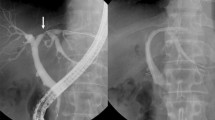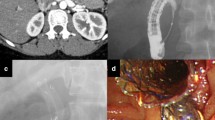Abstract
We report the case of a 78-year-old male patient with obstructive jaundice due to a pancreatic head neoplasm. The patient’s general condition did not permit an endoscopic approach and the presence of diffuse liver metastases prohibited hepatic puncture for percutaneous biliary drainage, therefore the transcolecystic transperitoneal approach was decided to be the safest decompression route. Through a gallbladder access, a Viabil-covered stent with a mesh extension was placed in the distal common bile duct, without complications. The patient died 8 months later without signs of stent dysfunction or necessity of reintervention. Transcholecystic transperitoneal access is a safe option when diffuse liver metastases prohibit the transhepatic approach, even in cases where placement of a covered stent is considered necessary.




Similar content being viewed by others
References
Picus D (1990) Percutaneous gallbladder intervention. Radiology 176(1):5–6
Hatzidakis AA, Prassopoulos P, Petinarakis I et al (2002) Acute cholecystitis in high-risk patients: percutaneous cholecystostomy vs conservative treatment. Eur Radiol 12:1778–1784
VanSonnenberg E, D’Agostino HB, Casola G et al (1990) The benefits of percutaneous cholecystostomy for decompression of selected cases of obstructive jaundice. Radiology 176(1):15–18
Miyayama S, Yamashiro M, Takeda T et al (2008) Acute cholecystitis caused by malignant cystic duct obstruction: treatment with metallic stent placement. Cardiovasc Interv Radiol 31(Suppl 2):S221–S226
Sheiman RG, Stuart K (2004) Percutaneous cystic duct stent placement for the treatment of acute cholecystitis resulting from common bile duct stent placement for malignant obstruction. J Vasc Interv Radiol 15(9):999–1001
Fanelli F, Orgera G, Bezzi M et al (2008) Management of malignant biliary obstruction: technical and clinical results using expanded polytetrafluoroethylene fluorinated ethylene propylene (ePTFE/FEP)-covered metallic stent after 6-year experience. Eur Radiol 18(5):911–919
Hatzidakis A, Krokidis M, Kalbakis K et al (2007) ePTFE/FEP-covered metallic stents for palliation of malignant biliary disease: Can tumor ingrowth be prevented? Cardiovasc Interv Radiol 30(5):950–958
Stempel LR, Vogelzang RL (1993) Hemorrhagic cholecystitis with hemobilia: treatment with percutaneous cholecystostomy and transcatheter Urokinase. J Vasc Interv Radiol 4(3):377–380
Vingan HL, Wohlgemuth SD, Bell JS III (1990) Percutaneous cholecystostomy drainage for the treatment of acute emphysematous cholecystitis. Am J Roentgenol 155(5):1013–1014
vanSonnenberg E, D’Agostino HB, Casola G et al (1991) Gallbladder perforation and bile leakage: percutaneous treatment. Radiology 178(3):687–689
Garber SJ, Mathleson JR, Cooperberg PL et al (1994) Percutaneous cholecystostomy: safety of the transperitoneal route. J Vasc Interv Radiol 5(2):295–298
Van Overhagen H, Meyers H, Tilanus HW et al (1996) Percutaneous cholecystostomy for patients with acute cholecystitis and an increased surgical risk. Cardiovasc Interv Radiol 19(2):72–76
Hatjidakis AA, Karampekios S, Prassopoulos P et al (1998) Maturation of the tract after percutaneous cholecystostomy with regard to the access route. Cardiovasc Interv Radiol 21(1):36–40
Miyayama S, Matsui O, Akakura Y et al (2003) Percutaneous cholecystocholedochostomy for cholecystitis and cystic duct obstruction in gallbladder carcinoma. J Vasc Interv Radiol 14(2 Pt 1):261–264
Author information
Authors and Affiliations
Corresponding author
Rights and permissions
About this article
Cite this article
Krokidis, M.E., Hatzidakis, A.A. Percutaneous Transcholecystic Placement of an ePTFE/FEP-Covered Stent in the Common Bile Duct. Cardiovasc Intervent Radiol 33, 639–642 (2010). https://doi.org/10.1007/s00270-009-9585-8
Received:
Revised:
Accepted:
Published:
Issue Date:
DOI: https://doi.org/10.1007/s00270-009-9585-8




